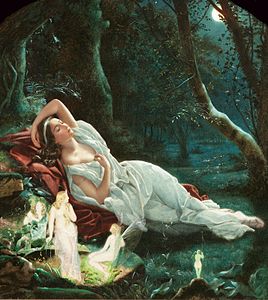John Simmons (painter)

John Simmons (1823–1876) was a British
Fairy painting
The typical

Simmons is best known as a specialist in painting female fairies, frequently nude.[5] Bonhams auctioneers described his 1873 depiction of A Midsummer Night's Dream as "one of the finest and most ambitious examples."[2] Interest in the fairy painting genre saw a revival in the 19th-century allowing observers of the imaginary world shown in the paintings a respite from the austerity of the Victorian way of life.[2] The majority of Simmons' paintings are simple and generally portray one or two main figures set within a framework of foliage; Titania was frequently a subject of his artwork, shown delicately draped in a variety of poses.[2] According to Bonhams he portrays "the fairy queen as a paradigm of Victorian female beauty"[2] adding "Using the winding flowers and convolvulus as a decorative motif, Simmons romantically frames the central figures, creating a stage in which their narrative can play out. Blurring the boundaries between reality and dreams, he creates a poetical vision of Shakespeare's play".[2]
Some of Simmons' images of Titania illustrate the increasing sexualisation of fairy queens.[9][10] According to Christopher Wood, an expert in Victorian art,[11] Simmons' technique demonstrated influence from Joseph Noel Paton, who utilised a very detailed style.[12] Wood also suggested further influence for Simmons' style came from William Edward Frost and William Etty.[13] Simmons' paintings of fairies are given a surreal effect by his skilful use of light and the realistic detail he adopts for portraying the animals and plants.[14] Wood described Simmons' A Fairy among Convolvulus as "a typical Simmons pin-up"[15] and hypothesises the paintings were "distinctly titillating".[16] Other pieces of artwork by Simmons with a fairy theme include: Hermia and the Fairies, which was also based on Shakespeare's A Midsummer Night's Dream and completed in 1861;[17] The Honey Bee Steals from the Bumble Bees;[18] and The Evening Star.[19]
References
- ISBN 9780486990040.
- ^ a b c d e f "Lot 52 John Simmons". Bonhams. 10 July 2013. Retrieved 15 November 2014.
- ISBN 9780312145941.
- ISBN 9780786428274.
- ^ a b Wood, p. 124.
- ^ "Bristol Academy of the Fine Arts". Bristol Mercury. No. 3084. 28 April 1849. p. 8 – via British Newspaper Archive.
- ^ "The late Mr John Simmons". Western Daily Press. No. 5767. 18 November 1876. p. 3 – via British Newspaper Archive.
- ^ "Victorian Fairy Painting from the Frick Collection". Antiques and the Arts Online. Retrieved 28 November 2014.
- ISBN 9781851493364.
- ISBN 9781402744884.
- ^ "Obituary of Christopher Wood", The Daily Telegraph, p. 29, 27 January 2009
- ^ Wood, p. 144.
- ^ Wood, p. 13.
- ^ Nahum, Peter. "John Simmons". The Leicester Galleries. Archived from the original on 21 December 2014. Retrieved 21 December 2014.
- ^ Wood, p. 128.
- ^ Wood, p.124.
- ^ Wood, p. 8.
- ^ Wood, pp. 126–127.
- ^ Wood, p.129.
